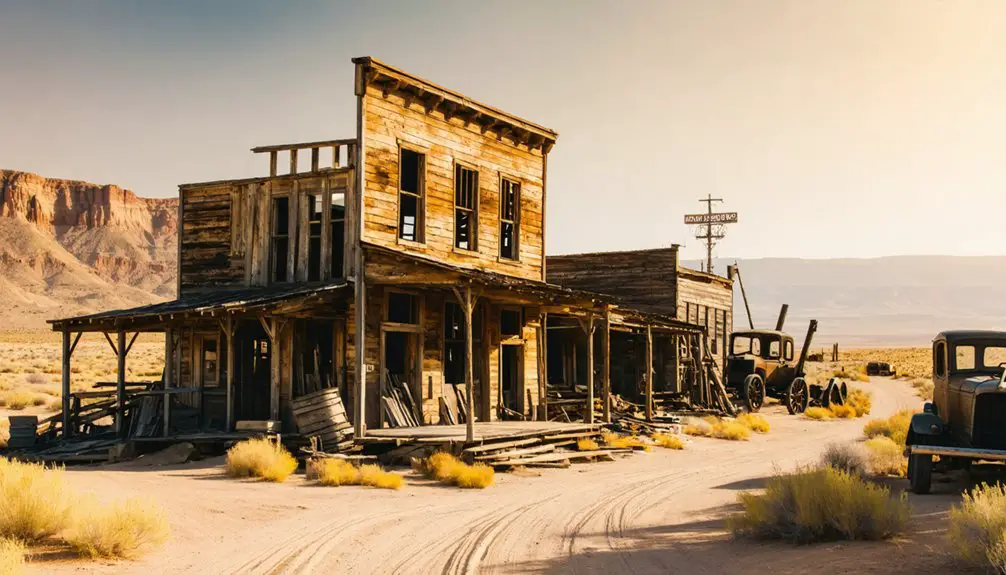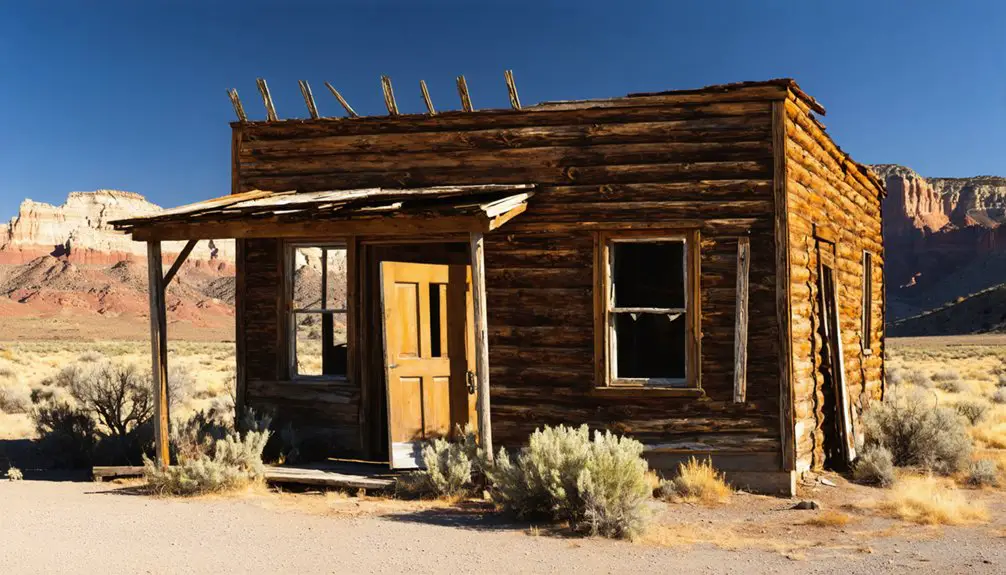You’ll find Asay ghost town at 7,000 feet along Utah’s Sevier River, where Joseph Asay founded the first homestead in 1872. The settlement featured a water-powered sawmill, shingle mill, and Jerome Asay’s general store with post office. Despite the pioneers’ determination, harsh environmental conditions, including frequent frosts and poor soil, made farming unsustainable. By 1900, families had abandoned the settlement, leaving behind remnants that tell a compelling story of frontier life’s challenges.
Key Takeaways
- Asay was established in 1872 by Joseph Asay along the Sevier River, becoming a small frontier settlement at 7,000 feet elevation.
- The settlement featured essential infrastructure including a water-powered sawmill, shingle mill, general store, and post office.
- Severe environmental challenges, including harsh winters, short growing seasons, and poor soil conditions, made sustainable farming impossible.
- The community gradually declined throughout the 1890s due to agricultural failures and harsh living conditions, leading to abandonment by 1900.
- Historical markers and records preserve Asay’s legacy as a cautionary tale of pioneer settlement challenges in Utah’s difficult terrain.
The Pioneer Settlement Years
When Joseph Asay established the first homestead near the Sevier River‘s headwaters in 1872, he laid the foundation for a small but industrious pioneer community.
Despite pioneer hardships, you’ll find that early settlers quickly developed significant infrastructure. Tom Jessup and Dan LeRoy constructed a water-powered sawmill, while a shingle mill began producing essential roofing materials. Jerome Asay’s general store and post office provided necessary supplies to the growing settlement. The short growing seasons made farming particularly challenging for the settlers. By 1900, the settlement had become a vacant ghost town due to environmental challenges.
The community’s resilience showed in their swift organization of religious and social structures. They built a multipurpose log building that served as both church and schoolhouse, where James Dutton and Isaac Asay led as presiding elders.
Life in Early Asay
Daily life in early Asay centered on the harsh realities of frontier existence. You’d find settlers working tirelessly to clear sagebrush with teams of oxen and mules, while facing the constant challenge of water scarcity.
The community’s resilience showed in their innovative solutions, like Peter Jensen’s 400-foot hand-dug well and the shared “Big Field” well that served multiple families. Jerome Asay became the town’s first postmaster in 1887.
Religious practices unified the settlement through their Mormon faith, with James Dutton and Issac Asay leading as presiding elders. You’d see the log meetinghouse bustling with activity as it served triple duty for church services, schooling, and social gatherings.
The settlement’s infrastructure included Tom Jessup and Dan LeRoy’s water-powered sawmill, while Jerome Asay’s store provided essential supplies. The Yardley Ranches LLC now owns and maintains the historic townsite.
Despite these developments, harsh winters and short growing seasons ultimately led to Asay’s abandonment by 1900.
Agricultural Dreams and Harsh Realities
Despite initial hopes of establishing a thriving agricultural settlement, Asay’s location at 7,000 feet posed insurmountable challenges for its pioneering farmers.
High-altitude dreams of agricultural success crumbled as Asay’s pioneers faced harsh realities at 7,000 feet above sea level.
You’ll find that the harsh climate severely limited crop diversity, with frequent frosts and a brief growing season destroying harvests before maturity. The settlers’ attempts at climate resilience proved futile as they battled extreme winters and unpredictable weather patterns. The remaining cabin and outbuildings stand as silent witnesses to their farming struggles. Like many locations listed in place name disambiguation, Asay became one of several abandoned settlements bearing this name.
While you can still see remnants of their determined efforts along Asay Creek, including a water-powered sawmill and shingle mill, these infrastructural developments couldn’t overcome nature’s constraints.
The combination of poor soil conditions, inadequate irrigation systems, and limited frost-free days made sustainable farming impossible.
Community Buildings and Social Structure
At the heart of Asay’s social fabric stood a multipurpose log house that served as the settlement’s church, school, and community center.
You’ll find this building represented the core of community cohesion, where religious gatherings under the leadership of James Dutton and Isaac Asay brought settlers together.
The social structure centered around prominent families, with the Asays playing key roles in both spiritual and economic life. Like those who founded Mormon pioneer settlements, Asay’s residents worked to create a self-sustaining agricultural community.
Jerome Asay’s store provided essential supplies, while the family’s religious leadership helped maintain order. The post office records helped document the town’s rise and eventual decline.
You can trace the settlement’s organizational ties through its 1892 integration with the Mammoth Ward at Hatch, connecting Asay to the broader LDS Church community.
The remains of farm outbuildings, a sawmill, and a surviving cabin reveal the settlement’s modest but structured communal life.
The Decline and Abandonment
The harsh environmental conditions at Asay’s 7,000-foot elevation began to erode the settlement’s sustainability by the late 1800s.
The extreme weather and short growing seasons led to repeated crop failures, creating severe economic hardships for the farming-dependent community. You’ll find that without irrigation systems or advanced agricultural methods, the settlers couldn’t overcome these environmental impacts. Like the catastrophe at Thistle, major flooding repeatedly damaged crops and homes.
Poor harvests and primitive farming methods left settlers powerless against nature’s fury at 7,000 feet elevation.
The town’s isolation and lack of infrastructure compounded these challenges. Unlike other settlements that discovered gold and silver in 1896, Asay never benefited from mining prosperity to sustain its economy.
With no commercial buildings or transportation networks to support alternative economic activities, residents had limited options for survival. As farming became increasingly unsustainable, families began leaving throughout the 1890s.
What Remains Today
Situated approximately 0.7 miles off US-89 west of Bryce Canyon, Asay’s remnants now rest on private property owned by Gilbert Yardley of Beaver, Utah.
The site’s current condition features a fairly intact cabin and several agricultural outbuildings, though they’re increasingly threatened by natural decay and overgrowth.
You’ll find the structures at an elevation of over 7,000 feet, where harsh winters and remote conditions create significant preservation challenges.
The wooden buildings stand as silent witnesses to the town’s farming heritage, distinguishing it from Utah’s more common mining ghost towns.
While exploring isn’t permitted due to private ownership, the homestead’s remains lie about 5 miles south of Hatch.
Be aware that hazards like uncovered wells make the area dangerous, even if you could access it.
Historical Significance and Legacy

Founded in 1872 by Joseph Asay and his family, Asay’s brief existence offers valuable insights into late 19th-century Mormon pioneer settlements in Utah’s high-altitude regions.
The settlement’s struggle with environmental challenges at over 7,000 feet exemplifies the broader pattern of boom-and-bust cycles in Western frontier towns. You’ll find Asay’s story preserved in cultural memory through historical guides, genealogical records, and county markers, serving as a testament to pioneer determination against harsh conditions.
The town’s legacy endures as a cautionary tale about the critical relationship between sustainable agriculture and settlement viability.
Its incorporation into the Mammoth Ward in 1892, followed by abandonment by 1900, demonstrates how environmental limitations ultimately shaped settlement patterns in Utah’s challenging terrain.
Frequently Asked Questions
Are There Any Known Paranormal Activities Reported in Asay’s Abandoned Structures?
You’ll find reported ghost sightings throughout abandoned buildings, with visitors documenting spectral figures, unexplained sounds, and cold spots. The haunted history includes accounts of whispering voices and childlike crying.
What Wild Animals Currently Inhabit the Abandoned Town Site?
During wildlife observation, you’ll spot mule deer, coyotes, rabbits, rodents, and bats using structures for shelter. Reptiles like rattlesnakes show territorial animal behavior, while raptors hunt around abandoned buildings.
How Safe Is It to Explore the Remaining Structures Today?
You shouldn’t explore these structures due to severe structural instability and numerous safety precautions required. Exploration risks include collapsing roofs, exposed nails, unstable floors, and legal consequences from trespassing.
Were Any Valuable Artifacts or Treasures Ever Discovered in Asay?
Like a dusty prospector’s dream, you’ll find rich historical discoveries here. Notable artifacts include Chinese currency, indigenous tools, and mining relics, though artifact hunting restrictions protect against treasure legends becoming reality.
What Natural Disasters Affected Asay During Its Inhabited Years?
You won’t find records of significant flood damage or earthquake impact during Asay’s inhabited period. While the area faced typical desert climate challenges, no major natural disasters are documented affecting the settlement.
References
- https://en.wikipedia.org/wiki/Asay
- https://www.ghosttowns.com/states/ut/asaytown.html
- https://jacobbarlow.com/2017/04/05/asay-settlement/
- https://jacobbarlow.com/tag/ghost-towns/page/3/
- https://www.familysearch.org/en/wiki/Utah_Ghost_Towns
- https://www.hmdb.org/m.asp?m=74676
- https://saltlake.citycast.fm/explainers/this-ghost-town-was-once-one-of-the-oldest-mormon-settlements-in-utah
- https://www.emerycountyarchives.com/uploads/1/4/0/7/140735053/asay_town_history.pdf
- http://www.expeditionutah.com/forum/index.php?threads/asay-town-aka-asay-settlement.7780/
- https://www.valleyjournals.com/2024/10/02/507818/exploring-utah-s-ghost-towns-seven-abandoned-settlements-with-fascinating-histories



